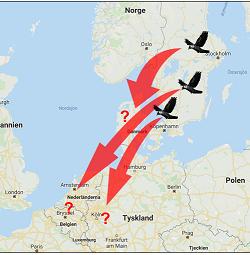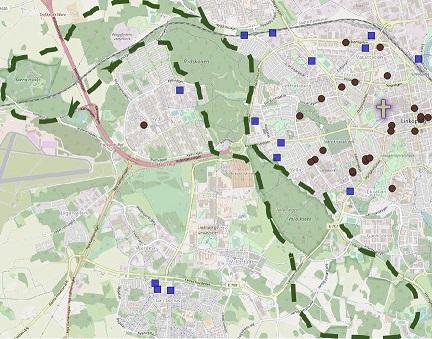Discussion & Conclusion
Discussion
I was surprised to find no seasonal differences in number of birds; this contrasts most other studies on urban jackdaws, where more individuals are usually found mid-winter than in the autumns. Also the fact that I found most birds on buildings rather than in trees stands in contrast.

Fewer individuals mid-winter here could possibly be explained by migration. Several south-Swedish ornithologial stations have noted larger amounts of jackdaws migrating S/SW in the past couple of years.
The propensity for building roosts rather than tree roosts can perhaps be attributed to the micro-climatic conditions around the chosen roost site. Buildings, especially in high densities, would be better at absorbing heat during the days and radiate it during the nights, than would trees. If wind-dampening effects are added to that, it might just be that by roosting on buildings the jackdaws experience a more comfortable night rest than they would in trees in the parks.

To some extent, I was also surprised with the results of the roosts v zero-sites comparison. My thinking was that the birds would choose roosts that lay rather close to suitable foraging grounds, but here they seem to have opted out on that.
For natural reasons we find more and larger green areas in the suburbs of the city and towards the city limits. Although these might be good foraging grounds areas, maybe the jackdaws avoid them due to the large forests in and around Linköping. In these forests we repeatedly find some of the jackdaws' foremost avian predators - Northern Goshawk (Accipiter gentilis) and European Sparrowhawk (Accipiter nisus).
Regarding flight lines usage and observation timing, I was content with > 80 % covered by the schedule chosen. Obviously you could cover more by observing until it's pitch-black, but that would be hard for me to combine with the city inventory.
The miniscule fraction (2.9 % of total individuals counted) coming in from the west puzzled me for a great while! There are vast areas of agricultural land west of Linköping - why no birds?
Most probably, this was a fault of my own, a flaw in the experimental design.
My observation point westwards had a very good view both westwards and eastwards, towards city centre.
However, instead of flying directly eastwards over Rydskogen into the city, jackdaws coming in from the west guide themselves via the slip road from the motorway into the city - a path unfortunately obscured from view at my westerly observation point. I stumbled upon this realisation well into the study by chance, on a walk one afternoon in December.
The 'true' fraction of birds coming in from the west therefore remains unknown, but considering the flocks I've encountered following the slip road into the city ever since I discovered that, the true number is probably one in the double digits; somewhere 10 — 20 % of the total.
Roost behaviour (flux of individuals) I will not comment too much on. The number of observations needs to be a lot larger to accurately say something specific. However, the flow that I did find gave me a hint that you should be cautious when asserting a number of individuals to a roost.
Conclusion
In my study, I have found:
- that the local jackdaws prefer to roost autumn & winter on high buildings, with complex roof structures, in the built-up areas of Linköping
- they come into the city mainly from the easterly and westerly directions, not so much from the north and the south
If you would want to try to 'build, and plan' for jackdaw-free cities at these latitudes, perhaps the take-home message could be:
Build low. Plan green.
Responsible for this page:
Director of undergraduate studies Biology
Last updated:
05/07/19
